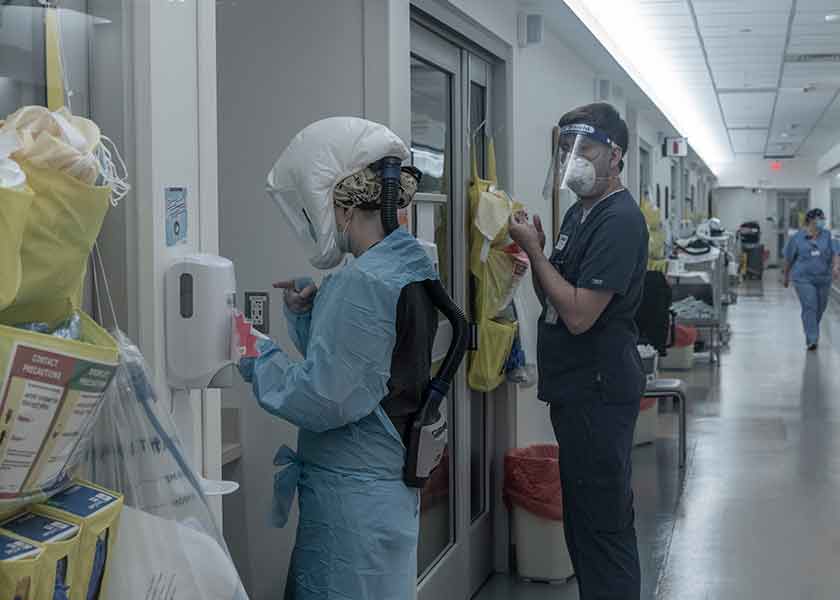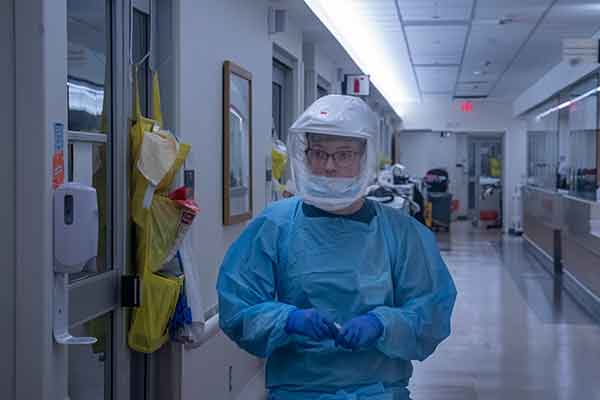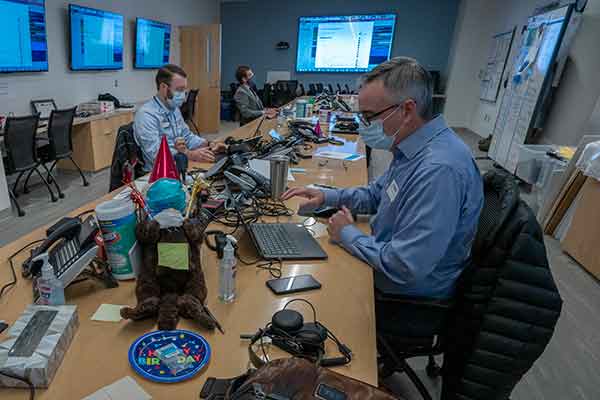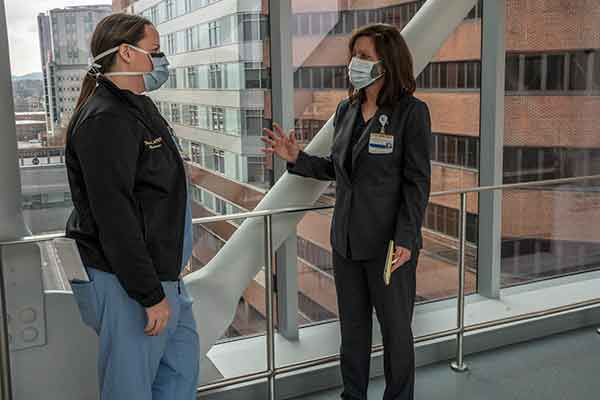
If you’re a member of the team caring for patients in the COVID-19 unit at Vanderbilt University Adult Hospital, you get to work by crossing from the main building to the Medical Center East North Tower via a sky bridge, whose big windows frame views of the Nashville skyline.
Some days you might pause there, just for a second, to soak up the vista and take a breath. Because from that point on—as you pass through a security checkpoint and two sets of locked doors on your way to a floor where most people aren’t allowed—the walls can feel like they’re closing in.
Crossing that sky bridge is how Lisa Flemmons, MSN’08, begins her 14-hour shifts on the U-shaped eighth floor of Medical Center East (MCE8), the hospital’s 37-bed COVID unit. Flemmons leads a team of fellow nurse practitioners who, along with registered nurses and attending physicians, manage care in the floor’s ICU. When the first critical patient arrived last March, Flemmons was at his bedside. (He survived.) She and her team—which includes a large number of Vanderbilt University School of Nursing alumni—have been on the job ever since.
Among the VUSN nurse practitioners tapped for the COVID unit were Brooke Bailey, DNP’16, Caroline Banes, MSN’07, Sarah Bloom, MSN’14, Jesse Byram, MSN’14, Kelly Daley, MSN’14, Shannon Ellrich, MSN’17, DNP’20, Emily Evans, MSN’08, Dan Ford, MSN’19, Elizabeth Huggins, MSN’14, Olivia Kirkpatrick, MSN’16, Janna Landsperger, MSN’06, Christy Noblett, BA’07, MSN’10, Wren Sherrill, MSN’16, and Dylan Van Lith, MSN’16.
“These are the sickest patients I’ve ever taken care of,” says Flemmons, who began working in critical care in 2007. “Every single patient is as sick as their neighbor, and you feel pulled in every direction. You’re worried about all of them, all the time. Working here means having the sickest patients in the hospital all in one place. It’s intense.”
 Alumni like Flemmons—from Vanderbilt’s schools of nursing, medicine, management, and more—have been at the center of VUAH’s response to COVID. Interviewed in November as an election that had turned a public health crisis into a political Rorschach test was finally grinding to its end, and as COVID infections were skyrocketing nationwide, Flemmons and other alumni reported feeling weary after eight months of life ruled by the coronavirus.
Alumni like Flemmons—from Vanderbilt’s schools of nursing, medicine, management, and more—have been at the center of VUAH’s response to COVID. Interviewed in November as an election that had turned a public health crisis into a political Rorschach test was finally grinding to its end, and as COVID infections were skyrocketing nationwide, Flemmons and other alumni reported feeling weary after eight months of life ruled by the coronavirus.
But they also acknowledged the effectiveness of strategies they implemented in the pandemic’s earliest days. They expressed gratitude for Vanderbilt’s collaborative culture, and a resolve to keep providing care that, even as vicious as COVID can be, was saving lives.
“Don’t stray from the things you know”
Last January, the accelerating spread of SARS-CoV-2 made it apparent that VUAH’s two-bed Contagious Disease Response Unit, created for the rare victim of Ebola or an emerging pathogen less widespread than the novel coronavirus, would not suffice if Nashville were to be hit hard. So administrators began planning for a major outbreak, starting with two central questions: Who would care for infected patients, and where?
To answer the first question, the hospital tapped Flemmons and her team of nurse practitioners from the medical ICU, where they had pioneered the hospital’s use of NPs to manage critically ill patients and were experts in caring for people with pulmonary disease—including Acute Respiratory Distress Syndrome (ARDS), a type of lung damage caused by several illnesses and often seen in COVID patients. The team also was versed in treatment with extracorporeal membrane oxygenation (ECMO), a sort of dialysis for the lungs used to oxygenate the blood of people with severe respiratory disease.
“These are the sickest patients I’ve ever taken care of”—Lisa Flemmons, MSN’08
Flemmons’ team was initially hesitant to leave the medical ICU to staff the front lines against a highly contagious, largely unknown disease—“It was like, well, OK, I guess we’re doing this,” recalls Susan Hellervik, MSN’09—but Flemmons soon joined other hospital staff in sizing up MCE8, which at the time housed recovering patients from the hospital’s other ICUs.
“We literally went room-by-room and said, ‘OK, we need these cords, these monitors, and these machines to run blood gasses,” Flemmons recalls. “We spent a couple of days trying to identify how we were going to convert the rooms into ICU rooms.”
The team learned to don and doff personal protective equipment every time they entered and exited a patient’s room. They mastered the use of PAPRS, respirators that blow filtered air into space-helmet-like hoods. Designated “dofficers” ensured that their colleagues didn’t inadvertently spread infection as they got in and out of gear. Associate Hospital Epidemiologist Dr. Bryan Harris, BS’05, MD’09, MPH’16, oversaw the training. He says the responsibility weighed heavily.
 “There was nothing that mattered more to me than making sure staff were safe,” says Harris. “These were my friends.”
“There was nothing that mattered more to me than making sure staff were safe,” says Harris. “These were my friends.”
In all, MCE8 came together quickly, with the hospital bypassing its usual deliberative, meeting-heavy process, and with medical staff from across departments volunteering to help however they could. In a matter of weeks, the floor was transformed into VUAH’s self-contained COVID unit, where all admitted patients with the virus would be treated, including patients who’d been admitted for other reasons, but tested positive. Not all patients would need intensive care, but any of the rooms could be quickly converted to an ICU room as necessary.
Faced with an illness about which medicine had more questions than answers, the hospital put its faith in the care Flemmons and her team had provided for years.
“Early on, when people were doing things that were not evidence-based and throwing a lot of drugs at this, my mentors told me, ‘You know how to practice critical care, and you’ve been taking care of ARDS patients for years. So don’t stray from the things you know.’ That was reassuring for my team,” Flemmons says.
Even if aspects of it were familiar, COVID packed surprises—like patients with dangerously low oxygen levels who somehow weren’t fighting for breath or turning blue.
“Normally, we’d be rushing to intubate those patients and get them on a ventilator,” Flemmons explains, “but with COVID, they’re looking at you saying, ‘I’m fine, why are you so excited?’ And you’re saying, “But you’re not fine! Put your oxygen back on!”
Preparing for a marathon
VUAH Chief of Staff Dr. Shubhada Jagasia, MMHC’12, says the hospital made several early moves that resulted in positive outcomes, including a COVID mortality rate for hospitalized cases that, as of mid-November, was 10.3 percent compared to 34 percent statewide.
“We said, ‘This is likely not going to be a sprint, but a marathon, so let’s set this up well,” explains Jagasia, who notes that her master of management in health care from the Owen Graduate School of Management, along with her MD, has helped her lead during a pandemic rife with unknowns.
 One key decision: creating a single, dedicated COVID service line, rather than stitching together care from a patchwork of services and specialties. Another: centralizing decision-making at a COVID command center staffed by providers from across disciplines poised to quickly resolve emerging issues.
One key decision: creating a single, dedicated COVID service line, rather than stitching together care from a patchwork of services and specialties. Another: centralizing decision-making at a COVID command center staffed by providers from across disciplines poised to quickly resolve emerging issues.
The hospital also standardized clinical treatment guidelines instead of leaving treatment to each provider’s discretion. Daily phone huddles, in which specialists consult on each patient’s case, further inform and personalize care.
“One of the striking things about this pandemic is that we’ve learned so much along the way,” says Dr. Tom Talbot, MD’96, MPH’03, the hospital’s chief epidemiologist. He points to the early assumption that asymptomatic spread of SARS-CoV-2, as with influenza, was unlikely. When data showed that people who weren’t sick could indeed infect others, the hospital had to turn on a dime and shift guidance for staff.
Talbot credits what he learned in Vanderbilt School of Medicine’s Master of Public Health program with helping him weed through the stacks of data, some of it published directly to social media without peer review, that have accompanied COVID: “You’re trying to understand the science while countering things that are out there that may be incorrect.”
“They don’t have anyone there”
One of the greatest challenges for the MCE8 team is the isolation patients endure because of strict infection-prevention protocols. Visitors weren’t allowed on the floor for the first several months of its operation, leaving patients without the lifeline of family, medical staff without insight into patients that only a family member can provide, and traumatized families without any way of knowing how their loved one was doing, beyond a single daily phone call from providers.
“It places an emotional burden on all of us,” says Ford. “You end up feeling closer to the patients who don’t do very well. You feel a responsibility to be connected to them because they don’t have anyone there.” When a patient dies, Ford says, “there’s no way it doesn’t eat part of your soul every single time.”
Over the summer, Flemmons and the ICU’s medical director, Dr. Todd Rice, MSCI’05, changed the visitation policy so that patients could have one visitor daily between 1 p.m. and 3 p.m. Visitors spend those hours in the hall outside their loved one’s room, in a chair pushed against the glass door, talking to them via iPad, sometimes even when the person in the room is sedated for days on end.
The staff on MCE8 can feel isolated, too, disconnected from patients and families, sealed away from colleagues, frequently wrapped in PPE, unable to step out for fresh air or a cup of coffee because of the constant monitoring patients require. Staff spouses can’t drop by with meals like they did pre-COVID. Co-workers fearful of infection steer clear. Going home to family means persistent worry about infecting them. And seeking support often leaves staff struggling to describe physically and emotionally grueling work that someone who hasn’t experienced it can’t really grasp.
Says Hellervik, “People ask us how we’re doing, and we say, ‘Fine.’ Because what are you going to say? These have probably been the hardest months of any of our professional lives.”
“You’re here, watching even young people die, and then you go to the grocery store and people aren’t even wearing masks. It’s like they just don’t care at all.”—Dr. Bryan Harris, BS’05, MD’09, MPH’16,
Harris says command center staff, working long hours month after month in a windowless basement room, aren’t immune from emotional stress, either.
“There have been times each of us has just been so overwhelmed that you just start crying,” he says. “I’m not a crier, but it has happened two or three times, where you just kind of have an emotional breakdown, and you’re close enough to people that you feel like you can be vulnerable.”

April Kapu, MSN’05, DNP’13, associate chief nursing officer for advanced practice, oversees the advanced practice registered nurses throughout the Vanderbilt system. She refers to a chart from the federal government mapping the phases of response that people and communities typically experience during a disaster; they’re not unlike psychiatrist Elizabeth Kübler-Ross’ stages of grief. On the chart, “heroic” and “honeymoon” phases are followed by a phase called “disillusionment.” Kapu, who is also a professor at the School of Nursing, says many of her colleagues are wrestling with that phase—and the risk of burnout—as case counts climb, and as the initial outpouring of public gratitude for health care workers has waned.
“[Staff] are almost at the stage where they feel abandoned, forgotten. People are going on about their regular lives, but you’re still doing the same thing,” she says.
“At first, you felt like you were in the midst of war, and your country back home was rooting for you,” Harris says. “And now, you’re here, watching even young people die, and then you go to the grocery store and people aren’t even wearing masks. It’s like they just don’t care at all.”
Amid the grief, the collaborative spirit among hospital staff, dictated by a credo most of them can recite, has been a buoy.
“I’m full of gratitude for the support people have given us, especially our colleagues, who’ve really stepped up and helped my team, knowing we were struggling,” Flemmons says.
Talbot credits ongoing orchestration across departments, with, among other wins, enabling VUAH to be one of the first institutions in the nation to develop its own testing capability.
“There’s a culture here that is different than anywhere else,” Ford says. “It’s the attitude of how individuals treat each other and the mutual respect and support they give each other. That makes a big difference in the care of these patients.”
The coming winter
By mid-November, the near-term outlook from MCE8 was unsettling. Cases and hospitalizations were increasing at a record pace around the nation; in Tennessee, the daily average had jumped 55 percent in the month’s first 14 days. VUAH’s COVID unit had about one-third more patients than it had in May and June. It had opened overflow beds on the floor below and activated a team of backup NPs. Chief of Staff Jagasia was concerned about capacity in a hospital that is “95-plus percent full on a good day.”
The promise of a vaccine glowed on the horizon, but in a nation receding under lockdown once more, a return to normalcy seemed, like the first day of spring, a long way off.
Flemmons and her team were still making the trip across the sky bridge, tired but determined. They had, she says, “prepared and planned and put a backup to a backup to a backup.”
“We’re all really nervous about winter,” she adds. “But we’re ready for it.”
Story by Kevin Jones
Images by John Partipilo
Images, from top:
A nurse in full PPE enters a patient’s room while another starts to don his PPE.
Alumna Lisa Flemmons looks out the window on the sky bridge leading to the COVID-19 unit at MCE8.
A nurse in PPE heads towards a patient’s room.
A look inside Vanderbilt’s COVID command center.
VUAH Surgical Critical Care Unit Director Elizabeth Huggins, MSN’14, and Associate Chief Nursing Officer for Advanced Practice April Kapu, MSN’05, DNP’13, consult on the skybridge.